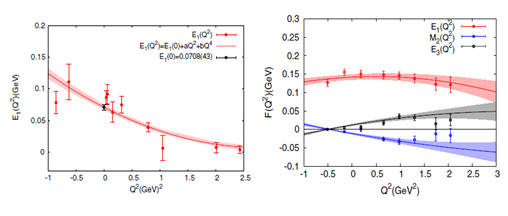New progress on the theoretical study of the glueball properties
Prof. CHEN Ying from the Institute of High Energy Physics and his collaborators made an important Figure Caption: The two figures show the Q2 dependence of the multipole from factors of J/ψ radiatively decaying into the scalar (left panel) and the tensor (right panel) glueballs, which are calculated from the numerical Lattice QCD calculation. The interpolated values at Q2=0 can be implemented directly to give the corresponding partial decay widths and the branching ratios.
progress on the theoretical study of the glueball properties in the framework of Lattice Quantum Chromodynamics (Lattice QCD). Their results have been published in Physical Review Letters (Phys. Rev. Lett. 110, 021601 (2013) and Phys. Rev. Lett. 111, 091601 (2013) ).

Prof. CHEN Ying’s research group performed, for the first in the world, a direct calculation of the production rates of the scalar and the tensor glueballs in the radiative J/ψ decays using the numerical simulation of Lattice QCD. The branching ratios of J/ψ radiatively decaying into the scalar and tensor glueballs are predicted to be 3.8(9)x10-3 and 1.1(2)x10-2 , respectively.
This is the unique theoretical prediction of QCD on this topic up till now. In comparison with the experimental data of the scalar mesons f0(1370), f0(1500), and f0(1710), this result supports f0(1710) as the best candidate for the scalar glueball. In the mean while, with the roughly 1% branching ratio they calculated for J/ψ radiatively decaying into the tensor glueball, they suggest BESIII to perform a scrutinized and systematic data analysis of the tensor products of J/ψ radiative decays and to give a definite assessment of the existence of the tensor glueball.
According to Quantum Chromodynamics (QCD), gluons, the particles that mediate the strong interaction, can combine into bound states called glueballs through their self-interaction. Glueballs are exotic hadron states and distinct from the conventional mesons and baryons described by the Quark Model. The existence or non-existence will have a deep impact on the understanding of the strong interaction.
Therefore, the search for glueballs is a long-standing major task for the experimental high-energy physics. The radiative decay of J/ψ is usually believed to be the best hunting ground for glueballs. Now the upgraded Beijing Electron and Positron Collider and the Beijing Spectrometer (BEPCII/BESIII) is accumulating the world largest data set of J/ψ events, which provides a promising opportunity to clarify the existence of glueballs. However, the present experimental data analysis requires more information for identifying glueballs states, which must be fed by the theoretical studies.
This project was supported by the National Science Foundation Committee of China (No. 11075167, 11021092, 10675101, 10947007, 10975076, and 10835002).